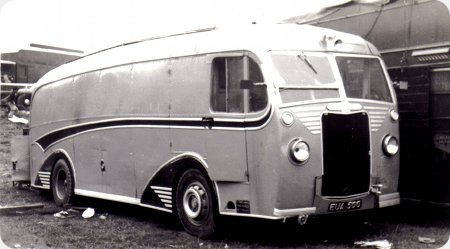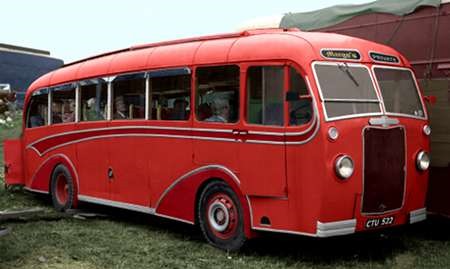Heaps Motor Tours – Maudslay Magna – EUA 500
Heaps Motor Tours
1937
Maudslay SF40 Magna
Holbrook C37F
This Maudslay Magna, chassis number 5333, was new to Heaps Tours in March 1937 and was sold to Baker, Featherstone in March 1951. Clearly, later still it joined the fair circuit. I have no other information but think the Yorkshire Tykes will be queuing up to furnish the detail.
Photograph and Copy contributed by Les Dickinson
17/12/15 – 07:45
What an interesting specimen, and what a great shame that the breed appears to be extinct! Thanks for posting.
Pete Davies
17/12/15 – 07:46
What a shame that not one of these revolutionary, and Maudslays most popular PSV chassis, ever survived.
Chris Hebbron
17/12/15 – 07:55
Any clues on the bodywork, Willowbrook perhaps?
Peter
18/12/15 – 06:22
The side flash looks Burlingham but the wheel arch embellishments more like Windover.
Eric Bawden
18/12/15 – 06:24
New -/37, to Heaps as mentioned with a Holbrook 37-seater front entrance body (quite an advanced idea at the time). It passed to Harold Baker t/a J Baker & Son 3/51. The Yorkshire Rose fleet name was in use by 12/54, while the coach left for pastures new 12/54. Presumably it passed to the showman at that time ?
MikeB
18/12/15 – 10:04
Thanks for that MikeB, Was this a solo vehicle or part of a batch, do you know. I thought the chrome strips on the wheel-arch trims may have been added by the showman.
Les Dickinson
18/12/15 – 10:04
Holbrook? That’s a brand most of us won’t have encountered before! It does, as Eric says, look a bit of a cross between Burlingham and Windover.
Pete Davies
19/12/15 – 07:03
Samuel Holbrook of Wolverhampton metamorphosed, in 1937, out of Holbrook & Taylors, also known as HT Bodies, but in the 1920’s more commonly known as Taylors of Wolverhampton! In 1930, it was specialising in 14-20 seater bodies for Ford and Chevrolet commercial chassis.
It built at least two bodies for the Magna, seemingly ordered by Maudslay as demonstrators or for Motor Shows of the period. This vehicle is likely to be first one. It is very attractive and still looks modern in the mid-1950’s.
Chris Hebbron
19/12/15 – 13:16
Can someone enlighten me as to what was so advanced or revolutionary about this model, please? Excuse my ignorance. My association with Maudslay vehicles was very limited, confined to some examples that Hutfields of Gosport operated, alongside some beautiful AEC Reliances with Burlingham Seagull bodies and some ex-Southdown lowbridge Leyland Titans.
David Wragg
20/12/15 – 08:04
According to David Kaye’s "Buses and Trolleybuses 1919-1945, it was one of the first chassis to have the front axle set back far enough to allow a front, not just forward, entrance (i.e. "Door Forward" rather than "Wheel Forward").
Graham Woods
20/12/15 – 08:06
According to Wiki (usual disclaimer)
A significant product was the SF40 front engined coach chassis, with set back front axle, which came onto the market in 1934. It achieved quite seccessful sales figures until the advent of WWII.
John Lomas
20/12/15 – 08:07
Although the 1933 AEC ‘Q’ was the first UK chassis to have the front axle set back to allow a true front entrance, it was a poor seller, apart from London Transport, who took 233 single deckers , although some of these had centre entrances. The engine was in the offside, tilted slightly. It was, perhaps, a step too far for the conservative-minded UK bus industry. The Maudslay SF40 adopted the same front entrance principle, but had the engine at the front, Ailsa-style; more conventional. It was produced not long after the ‘Q’s, in 1935, and sold in larger numbers to a wider number of users than the AEC, both in bus and coach form, maybe because the ‘Q’ had already blazed a trail and seemed less unusual by then. By 1937, Gardner 4LW/5LW engines were available and there is no evidence of any problems with heavy steering, which might have been a negative consequence. Here is a link to another SF40 thread on this site: //tinyurl.com/jrskqgt
Chris Hebbron
20/12/15 – 08:09
In the 1920s, Samuel Holbrook worked for Austin as a sales manager, but in 1930 went into partnership with the car body constructor, Taylors of Wolverhampton (this name was adopted to distinguish it from a competing firm called Taylor of Norwich). The company then adopted the revised title of Holbrook and Taylor. It was located in Park Lane, Wolverhampton, and concerned itself mainly with the construction of bodies for touring cars. Bus and coach bodywork soon formed part of the product range, and 14 to 20 seat bodies were offered for Ford and Chevrolet chassis. A 20 seat coach body by Holbrook and Taylor on a Commer Invader chassis was exhibited at the Scottish Motor Show in November 1930. In that same year the firm built an observation coach seating 30 passengers with a toilet compartment beneath the raised rear floor area. It was called the Bella Vista (now where have we seen that name again?). In 1933 Taylor withdrew from the business, which was reformed as Samuel Holbrook Ltd. The company built car bodywork for many of the major makers of the 1930s, and regularly displayed its car and commercial products at motor shows of the time. (There was also a contemporary Coventry based company called Holbrook that built car bodywork, but this had no connection with Samuel Holbrook.) The Commercial Motor edition for 5th November 1937 mentions a Holbrook bodied Maudslay SF40 Magna displayed at the Commercial Motor Show of that year – possibly this was the same machine illustrated above, though the seating capacity was then stated to be 40. A 26 seat Guy with full fronted bodywork was also shown. Despite its presence at such major marketing events, Holbrook went into receivership and disappeared from the motoring scene, supposedly in 1938. However, the historic fleet list for Delaine of Bourne shows a 1930 Leyland TS2 with a Duple body being given a new C37F body by Holbrook in 1939. Perhaps that was the year it entered service rather than the date of manufacture. The following links show examples of Holbrook bodywork:-
//nonsequitur.freeforums.org/one
//nonsequitur.freeforums.org/two
//nonsequitur.freeforums.org/three
The Maudslay SF40 Magna design has been discussed in detail elsewhere on OBP – see Gibson Brothers of Barlestone (Comfort Buses)- 1922 to 1940
Roger Cox
20/12/15 – 12:55
So, the products of Holbrook and Taylor were Wulfrunians, were they?
Season’s greetings to all our readers and, no, I’ve not started on the vino yet!
Pete Davies
20/12/15 – 12:56
Thank you everyone, that’s very helpful. It certainly looked advanced for the time and, of course, I should have noticed that the front axle was set back. Interesting that this model outsold the ‘Q’ from the mighty AEC, but as we know bus operators do tend to be very conservative, which is why there were only three customers for the Routemaster, and one of them, BEA, left operations in the hands of London Transport.
David Wragg
21/12/15 – 07:55
Being curious and living not far from Holbrooks in Coventry I thought I would look a bit further into Holbrook Motors. Did not find much except that Harry Holbrook built cars in USA around the same period using "English" technology. Were they related?
Roger Burdett
21/12/15 – 07:56
It occurs to me that we should not forget the other pre-war contender for a true front-entrance coach, the Tilling-Stevens Successor, ready for the 1936 Motor Show, but no vehicles were ever sold, probably because the company was not a mainstream psv provider by this time. The Duple body was actually centre-entrance, but a front entrance was surely possible, looking at the photo in Bus & Coach magazine at the following link: //tinyurl.com/h4mr4xr
Chris Hebbron
21/12/15 – 07:57
Heaps nearest competitor locally was one Sammy Ledgard who also had a Maudslay SF40 There is a picture of it on www.sct61.org.uk In later years it’s body was transferred to an ex London wartime Daimler decker!
Chris Hough
21/12/15 – 18:04
Did Samuel Ledgard buy this coach from new, or acquire it later?
Chris Hebbron
22/12/15 – 07:17
The US firm of Holbrook took its name from Harry F Holbrook who set up the company with John (known as Jack) Graham in 1908. Holbrook left the firm in 1913. After a period of growth in the 1920s, the company fell victim to the Great Depression, and closed in 1930. A comprehensive history of the firm may be found here:- www.coachbuilt.com/bui/h/holbrook/holbrook.htm
There appears to have been no connection with the Wolverhampton company.
Roger Cox
22/12/15 – 17:10
The Tilling Stevens Successor has been mentioned, but its eight cylinder boxer engine, independent rear suspension and Maybach-designed seven speed preselective constant mesh gearbox are probably reasons for a net sales figure of zero.
The only AEC Q’s to have provision for a "door-forward" layout (although generally without doors back then) were the double decks and the LT Central Area 5Q5 single deckers, the rest had too short a front overhang.
All but the first of the Northern General Transport SE6 single-deckers and all of their SE4s had front entrances (with a sliding door at the front bulkhead) as did 3/4 of the transverse rear engined preselective gearbox BMMO REC. They were of 1935 introduction.
Also at the 1937 Olympia Show was the Leyland Gnu TEP1 bodied as a front entrance bus by Walter Alexander. See this www.flickr.com/photos/one
Stephen Allcroft
23/12/15 – 06:42
The two Chris’s "H" – yes Ledgard did buy CUB 1 brand new – and later when the chassis was withdrawn its body was mounted on the chassis of the Park Royal "relaxed utility" ex London Transport HGF 948(D271). The removed body of the latter was later mounted on the Ledgard Daimler CWA6 JUB 649, whose own Duple body had very uncharacteristically deteriorated prematurely. The Brush body of CUB 1 made for a very strange coach indeed, while the Park Royal body gave JUB 649 a fascinating air by being a unique mixture. For more information see this link.
Chris Youhill
19/11/19 – 16:28
For those interested, I have re-registered the vehicle and returned it to service!
Steve Thoroughgood
11/09/22 – 06:02
That’s wonderful news, Steve. Must be unique by now.
Chris Hebbron
Quick links to the - Comments Page - Contact Page - Home Page
Comments - Please note: The comments facility is not currently available. Please see the home page for updates.
Please Note if you want to send a photograph with your comment please use the Contact Page by clicking here or send as an attachment via email.


